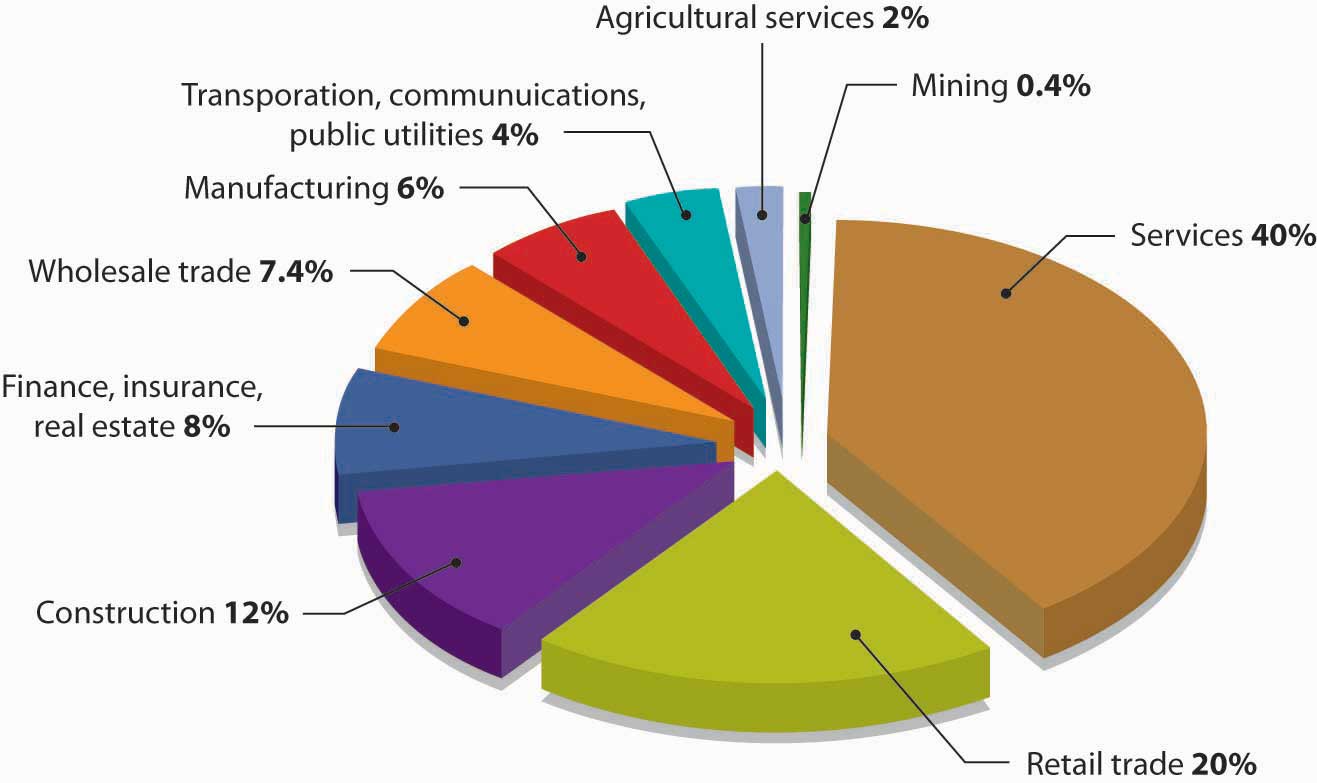This is “What Industries Are Small Businesses In?”, section 5.3 from the book An Introduction to Business (v. 1.0). For details on it (including licensing), click here.
For more information on the source of this book, or why it is available for free, please see the project's home page. You can browse or download additional books there. To download a .zip file containing this book to use offline, simply click here.
5.3 What Industries Are Small Businesses In?
Learning Objectives
- Describe the goods-producing and service-producing sectors of an economy.
- Identify the industries in which small businesses are concentrated.
If you want to start a new business, you probably should avoid certain types of businesses. You’d have a hard time, for example, setting up a new company to make automobiles or aluminum, because you’d have to make tremendous investments in property, plant, and equipment, and raise an enormous amount of capital to pay your workforce.
Fortunately, plenty of opportunities are still available if you’re willing to set your sights a little lower. Many types of businesses require reasonable initial investments, and not surprisingly, these are the ones that usually present attractive small business opportunities.
Industries by Sector
We’ll have more to say about industries and how to analyze them in later chapters. Here, we’ll simply define an industry as a group of companies that compete with one another to sell similar products, and we’ll focus on the relationship between a small business and the industry in which it operates. First, we’ll discuss the industries in which small businesses tend to be concentrated. To do this, we’ll divide businesses into two broad types of industries, or sectors: the goods-producing sector and the service-producing sector.
- The goods-producing sectorAll businesses whose primary purpose is to produce tangible goods. includes all businesses that produce tangible goods. Generally speaking, companies in this sector are involved in manufacturing, construction, and agriculture.
- The service-producing sectorAll businesses whose primary purpose is to provide a service rather than make tangible goods. includes all businesses that provide services but don’t make tangible goods. They may be involved in retail and wholesale trade, transportation, communications, finance, insurance, real estate, and such professional activities as health care, advertising, accounting, and personal services.
About 80 percent of small businesses in the United States are concentrated in the service-producing sector. Of these, about 25 percent are in retailing, 10 percent in wholesaling, and 35 percent in professional and business services. Of the 20 percent of all small businesses in the goods-producing sector, nearly two thirds are in construction and the other one third in manufacturing.John Case, “What Businesses Are Small Companies Really In—And Where Are They Scarce,” Inc.com (May 2001), http://www.inc.com/magazine/20010515/22612.html (accessed October 11, 2008) (October 11, 2008).
Figure 5.5

A high percentage of small businesses are in the retail sector.
© 2010 Jupiterimages Corporation
The high concentration of small businesses in the service-producing sector reflects the makeup of the overall U.S. economy. Over the past forty years, the service-producing sector has been growing at an impressive rate. In 1960, for example, the goods-producing sector accounted for 38 percent of GDP, the service-producing sector for 62 percent. By 2000, the balance had shifted dramatically, with the goods-producing sector accounting for only 23 percent of GDP, while the service-producing sector had grown to 77 percent.Laura Baughman, “Why Congress Should Fund Better Services Data,” Sitrends.org (May 6, 2002), http://www.sitrends.org/ideas/expert.asp?EXPERT_ID=49 (accessed October 11, 2008) (October 11, 2008).
Goods-Producing Sector
The largest areas of the goods-producing sector are construction and manufacturing. Construction businesses are often started by skilled workers, such as electricians, painters, plumbers, and home builders. They tend to be small and generally work on local projects. Though manufacturing is primarily the domain of large businesses, there are exceptions. BTIO/Realityworks, for example, is a manufacturing enterprise (components come from Ohio and China, and assembly is done in Wisconsin).
Another small manufacturer is Reveal Entertainment, which was founded in 1996 to make and distribute board games. Founder Jeffrey Berndt started with a single award-winning game—a three-dimensional finance and real estate game called “Tripoly”—and now boasts a product line of dozens of board games. There are strategy games, like “Squad Seven,” which uses a CD soundtrack to guide players through a jungle in search of treasure; children’s games, like “Portfolio Junior,” which teaches kids the rudiments of personal finances; and party games, like “So Sue Me,” in which players get to experience the fun side of suing their neighbors and taking their possessions.Go to Reveal Entertainment at http://www.revealgames.com (accessed October 11, 2008) (October 11, 2008).
Service-Producing Sector
Many small businesses in this sector are retailers—they buy goods from other firms and sell them to consumers, in stores, by phone, through direct mailings, or over the Internet. In fact, entrepreneurs are turning increasingly to the Internet as a venue for start-up ventures. Take Tony Roeder, for example, who had a fascination with the red Radio Flyer wagons that many of today’s adults had owned as children. In 1998, he started an online store through Yahoo! to sell red wagons from his home. In three years, he turned his online store into a million-dollar business. Internet entrepreneurship was also attractive to Sean Lundgren and Todd Livdahl—two computer engineers who gave up successful careers at Disney to turn their fascination with video games and DVDs into an online business. To their delight, their small start-up venture, a CD and DVD retailer that they call Sneetch.com, generated sales of $1.2 million during its first year of operation.Isabel Isidro, “What Works on the Web: 12 Lessons from Successful Home-Based Online Entrepreneurs,” PowerHomeBiz.com (2008), http://www.powerhomebiz.com/vol63/whatworks.htm (accessed October 12, 2008) (October 12, 2008).
Other small business owners in this sector are wholesalers—they sell products to businesses that buy them for resale or for company use. A local bakery, for example, is acting as a wholesaler when it sells desserts to a restaurant, which then resells them to its customers. A small business that buys flowers from a local grower (the manufacturer) and resells them to a retail store is another example of a wholesaler.
A high proportion of small businesses in this sector provide professional, business, or personal services. Doctors and dentists are part of the service industry, as are insurance agents, accountants, and lawyers. So are businesses that provide personal services, such as dry cleaning and hairdressing.
David Marcks, for example, entered the service industry about fourteen years ago when he learned that his border collie enjoyed chasing geese at the golf course where he worked. Anyone who’s been on a golf course recently knows exactly what the goose problem is. While they are lovely to look at, they answer the call of nature on tees, fairways, and greens. That’s where Marcks’s company, Geese Police, comes in: Marcks employs specially trained dogs to chase the geese away. He now has twenty-seven trucks, thirty-two border collies, and five offices. Golf courses account for only about 5 percent of his business, as his dogs now patrol corporate parks and playgrounds as well.Isabel M. Isidro, “Geese Police: A Real-Life Home Business Success Story,” PowerHomeBiz.com (2008), http://www.powerhomebiz.com/OnlineSuccess/geesepolice.htm (accessed October 8, 2008).
Figure 5.6 "Small Business by Industry" provides a more detailed breakdown of small businesses by industry.
Figure 5.6 Small Business by Industry

Key Takeaways
-
An industry is a group of companies that compete with one another to sell similar products. There are two broad types of industries, or sectors:
- The goods-producing sector includes all businesses that produce tangible goods.
- The service-producing sector includes all businesses that provide services but don’t make tangible goods.
- The largest areas of the goods-producing sector are construction and manufacturing. Construction businesses are often started by skilled workers, such as electricians, painters, plumbers, and home builders. These businesses tend to be small and generally focused on local projects. Though manufacturing is primarily the domain of large businesses, there are exceptions.
- Many small businesses in the service-producing sector are retailers—they buy goods from other firms and resell them to consumers, in stores, by phone, through direct mailings, or over the Internet. Other small business owners in this sector are wholesalers—they sell products to businesses that buy them for resale or for company use. A high proportion of small businesses in this sector provide professional, business, or personal services.
Exercise
Why are most small businesses found in the service-producing sector? Identify five small service-producing businesses that you patronize frequently. What kinds of small businesses are found in the goods-producing sector? What small goods-producing firms do you do business with regularly?




